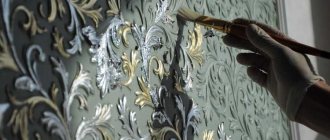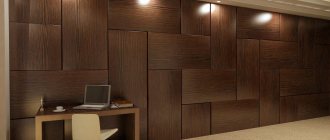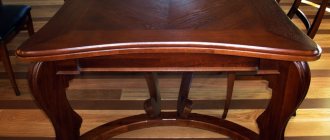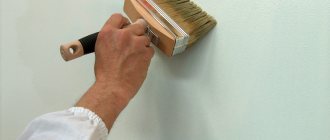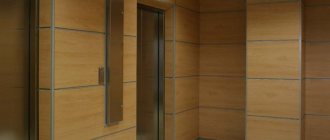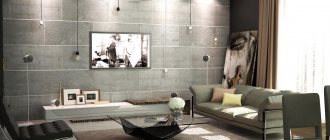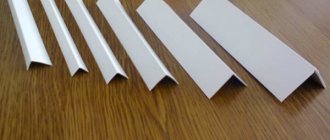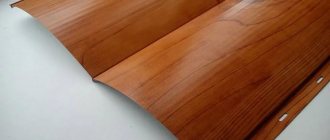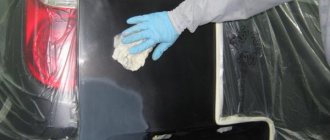Decorative wall decoration, that is, interior finishing work, is the most “delicious” creative part of the renovation. A variety of ideas for decorating walls, decorating the comfort of your own home or office are achievable today more than ever! The market offers a myriad of finishing materials for indoor walls. There has long been a succinct saying that even the walls of a home can heal—it’s not for nothing that people say that. To ensure that a large selection does not lead to some confusion, it is enough to have a clear idea of what you want, as well as a little understanding of what modern finishing materials are.
A lovingly thought out, harmonious interior truly relieves stress and calms you down.
Decorating walls with various materials, which has become so organically relevant and so beloved, has a number of advantages:
- such design is almost always unique, inimitable;
- adaptable to absolutely any stylistic decision - from classic to the most daring;
- perfectly camouflages light unevenness and surface defects;
- significantly increases sound insulation;
- significantly enhances the moisture resistance of surfaces.
Paint for interior wall decoration
Painting is the most common, main available method of decorating walls. It is based on the application of coloring materials (paints) to the surface. A huge selection of colors, the presence of various techniques (which can be used even without special training) make it especially popular. For interior coatings, mainly two main types of paint are used: either acrylic or alkyd.
Acrylic paints include water-based and water-based dispersion paints. Advantages: this dye is affordable, easy to work with (due to its composition, practically odorless), it is suitable for decorating absolutely any room. Most often, acrylic paints are used to cover large surfaces; they dry very quickly.
Decorative wall decoration, photo:
Alkyd paint is used a little less frequently; it is dissolved with white spirit or turpentine.
Advantages: indispensable for working on large, small wooden or metal elements - window, door frames, pipes, heating radiators. By combining different gradations, tones of the same color, related or contrasting colors in one room, you can easily create a unique, unusual, but cozy space.
Sealing joints with plaster
Sometimes they use fragmentary plaster rather than continuous plaster, covering problem areas of the base. Most often this concerns brick and panel houses built a long time ago with differences in levels , especially at rustications (joints between individual slabs of walls and ceilings). In order not to solve this problem with the help of expensive plasterboard structures, plaster is used. In addition to level differences, cracks appear at the joint sections of the walls, through which heat leaks from the room.
Sealing joints with plaster
During use, the walls shrink, causing the original mortar inside the joints to crack. This problem is familiar not only to residents of old buildings, but also to new economy class buildings. The fact is that developers there primarily focus on speed and low cost of construction, to the detriment of quality. By sealing problem seams, both a decorative and thermal insulation effect is achieved. Before laying the mortar, the joint must be reinforced with a sickle mesh.
Decorative plaster for interior wall decoration
Another undisputed leader in the construction market used for interior work is decorative plaster. This is an excellent finishing material for walls inside the apartment.
No wonder, because the advantages of this material are obvious:
- protection from mechanical damage;
- individual design of rooms is achieved with a minimum of effort;
- the composition includes environmentally friendly natural materials;
- the condition remains good for a long time, keeps its shape perfectly;
- washes and cleans well.
In appearance, decorative plaster is a special heterogeneous mixture of different structures and grain sizes. For interior work, compositions that dissolve with water are ideal (they do not have a strong odor).
In the photo the walls are decorated with decorative plaster:
As a rule, plasters can be tinted, that is, several shades of pigments can be mixed in order to achieve an individual exact tone, to fully realize the plan. There are a lot of techniques for applying plaster, all of them are quite simple to perform.
What to choose
During the renovation process, many may face the problem of choosing suitable options. It’s no wonder, there are a lot of materials available today, each of them has its own advantages, it’s not clear what to buy. I hope my article will make your task much easier, and you will not regret the money spent.
New materials imply greater responsibility in choosing finishes
Idea 1. Wallpaper
Wallpaper has been a popular finish for many years.
For many years, wallpaper still refuses to give up the palm in the competition for the most popular finishing material. The assortment is more than impressive: here you can find relatively inexpensive paper, more expensive and durable vinyl, and even wallpaper with a 3D effect.
Spectacular wallpaper can qualitatively transform the interior
Plastering is one of the most labor-intensive wall finishing processes, during which a lot of dirt and debris appears. Therefore, before starting to implement it, it is important to understand why it is needed and whether it is possible to refuse it.
Table of contents:
Wall decoration with wallpaper
Classic wallpapering, it seems, will never cease to be relevant, simple, and affordable.
Currently, the choice of high-quality, sophisticated wallpaper is very wide. The most common:
- paper classic;
- washable vinyl;
- non-woven;
- natural;
- represented by liquid textures.
Ordinary paper wallpapers can be background or embossed, single-layer or double-layer. Considering their environmental friendliness, they are simply irreplaceable for a child’s room or bedroom, they are inexpensive, “breathe”, and easy to glue. The other side of the coin regarding the types of wallpaper finishes: they are short-lived, fade, and get dirty easily.
Non-woven wallpaper is non-woven, high density, applied to paper. They have great strength, but at the same time allow air to pass through. Cracks and surface roughness are camouflaged. They are very easy to stick - the adhesive mass needs to be applied only to a solid base.
Vinyl wallpaper is foamed vinyl applied to a paper or non-woven backing. They can be smooth, embossed, with a pattern, made using hot stamping or silk-screen printing.
They are great for hallways and corridors, as they are moisture resistant, which means they are easy to wash and clean. Such wallpapers retain their color saturation for a very long time, practically do not fade, and are airtight (therefore, it is better not to glue them to the walls of a bedroom or nursery).
Natural wallpapers are made from environmentally adaptive, natural derivatives:
- traffic jams;
- jute;
- straws;
- veneer;
- bamboo;
- reed;
- seaweed
They are applied to a paper or, less commonly, non-woven base. This is an exclusive, very cozy, pleasant to the touch decorative material. To protect against dust, the manufacturer treats such wallpaper with special means. Most often, such natural coatings are used to emphasize individual elements. They are somewhat capricious and require protection from sunlight.
When not to plaster walls?
Situations when you can do without plastering walls:
- When decorating walls with clapboard, siding, plastic, etc. In this case, the rough base must be thick and durable.
- Leveling is carried out with plasterboard boards. The requirements for the rough foundation are the same as in the previous case.
- Smooth entire walls made of monolithic concrete or slabs. Before wallpapering or painting, it is enough to putty them.
- Buildings made of quality limestone. This material does not require additional protection, maintaining its original quality for hundreds of years.
Decorative panels for interior wall decoration
Today, the construction market offers a wide range of similar decorative materials for interior wall cladding. The shape and material of manufacture, coupled with convenience and speed of installation, allow you to achieve excellent results quickly and relatively inexpensively. Using panels you can hide imperfections, irregularities, electrical wiring, and other building communications. These decorative materials are attached to a special metal sheathing, which is initially mounted on the mother surface.
Decorative panels are presented as sheets, rectangular canvases, narrow slats. Thus, you can choose an individual, convenient cladding option; they can be installed horizontally or vertically. The most popular, frequently used type of this decorative coating is made from fiberboard, chipboard, MDF, polyvinyl chloride, gypsum, natural (or recycled) wood, and cork. Decorative 3D analogues stand out.
Photos of wall cladding with different materials:
High-quality panels for interior cladding must be environmentally friendly, resistant to moisture and temperature changes. Using different cleaning agents should not be a problem, low flammability in case of fire is also important.
Summary
How interesting the interior is depends only on the owner - get creative!
Summing up everything that has been described here, it should be noted that it depends only on you what your home will look like. And it’s up to you whether you and your family want to return there again and again. Even budget wall decoration, made by painting surfaces, has the right to be, and perhaps, quite attractive.
Remember, to create an atmosphere of warmth and comfort, the main thing is that you like the changes that you have conceived and are implementing.
And the video in this article will help you finally make your choice, watch it!
Beautiful finish – successful renovation!
Modern wall decoration in an apartment is one of the most important stages of any renovation. A well-chosen type of decoration will not only help make your dream interior a reality, but will also save money and time.
And so that in the process of choosing a finish you are not based only on the feeling of “oh, this doesn’t look good,” I suggest you familiarize yourself with the most popular and proven materials with their advantages and disadvantages.
Don't know what the walls in your apartment are decorated with? The choice is quite wide!
Wall finishing with plasterboard
Drywall is a modern, inexpensive material, a reasonable alternative to plaster when creating a flat surface is required. Even a novice builder can handle drywall; it is non-toxic, non-flammable, and after working with it there is no large amount of dust or construction debris left behind.
The advantages of plasterboard cladding are:
- excellent sound insulation;
- maintaining an acceptable indoor microclimate;
- environmental friendliness;
- the ability to implement any design designs;
- compatibility with other finishing materials that can be used as a topcoat;
- low price.
When working with drywall, you should take into account its fragility; it also needs a reliable frame. If there is an increased level of humidity, then, most likely, it may be necessary to pre-coat the mother surface with a special primer.
Pros and cons of plaster
Wall plaster comes in several varieties, each of which has its own advantages and disadvantages. However, there are also general characteristics of this type of finish.
Pros of plaster:
- Cheap material . This type of finishing is considered one of the cheapest. First of all, this applies to traditional cement plaster, which, in addition to cement, also contains sand and water. If there are sand deposits near the dacha, then you won’t have to buy it. Even a layman knows how to prepare the simplest solution: add water to a dry mixture of sand and cement (3:1) and stir. Gypsum plasters, mainly used indoors, are sold dry and are also inexpensive.
- Easy to apply. To plaster walls, you will need minimal construction experience. To begin with, you can practice in non-main premises such as a summer kitchen or barn, and then move on to your home. Obtaining a perfectly flat surface is made easier by using beacon strips.
Even a beginner can handle applying plaster
Disadvantages of plaster:
- The complexity of the process. Despite its simplicity, plastering work will require considerable physical effort to prepare the solution and apply it. To facilitate the procedure, construction mixers and mechanized laying are used to finish large areas.
To facilitate the application of plaster, mechanized laying is used.
The plaster has to be chipped for electrical wiring
Clinker tiles for interior wall decoration
The use of this modern, up-to-date facing material makes it easy to implement the design concept - a high-quality imitation of wood, stone or brickwork. Today, clinker tiles are in demand because, in addition to their high performance qualities, they look very aesthetically pleasing and are not inferior to the natural materials that they imitate.
Clinker imitation stone, photo:
Such tiles are easy to work with, their minimum thickness is only 8 mm, they have a long service life and are resistant to mechanical damage. If you are tiling a kitchen or bathroom, then the level of moisture resistance of this coating must be appropriate.
Clinker tiles have a rich range of colors, and over time the shades do not fade or fade. For cladding, you can choose a material of any texture: smooth, glazed, rough, rustic. Clinker tiles are not affected by mold or various types of fungi, do not emit toxic fumes, are fire resistant, and durable.
Photo wallpaper
The most dynamic form of wall decoration is photo wallpaper. They look great in almost any interior, but not in every style. Interiors of modern, eclectic, industrial, minimalist styles can be decorated using photo wallpaper, which will create a unique finishing option. In an interior in Provence or rustic styles, we must choose natural themes for wall decoration, such as stone, brick, which can look great on photo wallpaper.
The undoubted advantage of photo wallpapers is their versatility. They can be used in the kitchen, bathroom, hallway, living room and bedroom. Photo wallpapers are not only a great decoration for a modern interior, they can also create an optical trick that will enhance the interior visually, add dynamism and soothe the senses. Photo wallpapers stimulate the imagination well. As a result, we can create an interior that is very impressive and influences emotions.
Brick panels for interior wall decoration
Often, the design concept of the interior design requires a realistic embodiment of brickwork. Internal brick cladding looks stylish, modern, and differs from real brick finishing in saving space, time, and effort. Using this material, you can decorate a separate wall or partitions between rooms, or decorate the entire room for masonry, if the situation requires it.
Brick panels are available in a variety of colors and textures, and they perfectly hide defects and utility lines. They harmoniously combine with wallpaper, plaster, painted or wooden parts of the interior. With the help of brick panels you can place accents and create a unique, completely individual interior. The most commonly used brick imitations are made from polyvinyl chloride and MDF.
Types of decorative wall finishing - brick cladding, photo:
The advantages of this facing coating:
- easy installation - even a beginner can handle it;
- easy cutting (convenient to join corners);
- no additional finishing work;
- good sound insulation;
- additional thermal insulation;
- no need to pre-level the work surface;
- replacement of individual panel fragments if damaged.
An acceptable pricing policy is also a significant advantage when choosing this brick decoration.
Elegance of style: effects, drawings, panels
Using special application techniques, you can achieve various effects: aging, cracking, roughness, volume, relief, “wet silk”. Most of the proposed types of decorative plaster mixtures are easy to apply and do not require advanced skills when working. However, there are also types that can only be used by a master who knows everything, even the smallest nuances. For example, Venetian plaster requires painstaking and careful work in order to ultimately create a clear imitation of marble.
The same applies to various drawings and panels, which today are becoming popular when carrying out interior finishing work in various rooms. Drawings using decorative plaster can be created in different ways: using a stencil, decorative painting or stucco molding (for panels). This makes it possible to add zest to the interior of any room, making it original, stylish and lively.
Wall finishing with laminate
We all know that laminate has long been successfully used for flooring. It looks aesthetically pleasing and is relatively inexpensive. Not so long ago, designers decided to use laminate for wall decoration. This design move—wall laminate for interior decoration—unexpectedly caught the taste of customers and began to be used to accentuate individual interior details. Naturally, a surface completely covered with laminate will look ridiculous, but skillfully introduced inserts or fragments will only emphasize the individuality of the style.
Laminate cladding, photo:
If you correctly select the shades of the laminate and combine them with the colors of the floor or wallpaper, you will be able to advantageously emphasize the nuances of any style direction - from high-tech to timeless classics. Laminate fragments can be mounted horizontally or vertically.
Wooden panels for interior wall decoration
No matter how many new building materials appear on the market, natural wood will always be in demand and relevant. Such cladding undoubtedly has a lot of positive qualities, but it is the appearance that plays the main role. Solid, practical, presentable wooden panels look appropriate in any room. They can also be made as an imitation of natural wood. This option will also look good, its price will be much lower than its analogue made from natural wood. We are talking about MDF and fiberboard/chipboard cladding.
Wooden panels, photo:
The advantages of this coating are long service life, environmental friendliness, and soundproofing qualities. With its help, you can easily and quickly hide flaws and irregularities, highlight separate areas in the room, and give it respectability. Wooden cladding products do not lose their external and operational qualities for a long time; they will look appropriate in an apartment, country house or country house. If you wish, you can choose any color scheme of the material, its texture, shape.
Artificial stone for interior wall decoration
It looks authentic and, surprisingly, harmonious, and is available in different colors and textures. It can be used to highlight individual details or corners in a room; it harmonizes perfectly with wallpaper or plaster. With the help of artificial stone, you can realize any design fantasies. Even a small fragment of a room (for example, the entrance door area), decorated with this cladding product, can change the perception of the room as a whole.
Artificial stone, photo:
This is a reliable imitation of a wide variety of natural textures; sometimes, artificial stone is even difficult to distinguish from natural rocks. It is much lighter in weight than its authentic counterpart, its scope of application is much wider due to its versatility.
Artificial stone adapts to the room temperature and will never feel cold when touched. It is easy to attach to any surface, be it wood, concrete or brickwork - it is very convenient. This decorative element is environmentally friendly, made from cement, water, appropriate dyes, sand impurities, water, and plasticizers.
Wall decoration with plastic panels
Plastic is a truly universal facing material. It can be installed in absolutely any room; it is not afraid of moisture or low temperatures. The low price is a pleasant bonus against the backdrop of the undeniable advantages of this facing product. Plastic elements have a wide range of colors, shades, and can be of different widths and lengths (there are also square and rectangular tiles). This cladding is characterized by a long service life and high moisture resistance, thanks to the locking type of connection of the elements.
Photo of the working process:
The soundproofing and heat-insulating aspect also takes place (cellular structure inside the panel). The surface of modern plastic panels can be made to resemble wood or ceramic imitation, marble, or leather covering.
The parts are easily mounted on any surface (frame sheathing is required), do not require high construction skills, and after working with them a minimum of construction waste remains. Such finishing panels are easy to care for (abrasive products cannot be used); along with cold, they are able to withstand high temperatures.
Wood wall decoration
As mentioned above, wood is a magnificent, environmentally friendly, visually attractive decorating material. For these purposes, a variety of species are used: oak, apple, walnut, spruce, pine, birch, alder, linden, larch. When choosing wood, you must take into account its texture, for example, the same coniferous species may have multiple eyes and knots.
Photo of wood cladding:
By choosing wood cladding, you provide the room with not only a presentable appearance, but also a favorable atmosphere (moisture exchange, thermal insulation qualities, pleasant smell). Today, it is important to cover walls with clapboard, timber, blockhouse, board, so-called wooden wallpaper, gusvarblock. Let's take a closer look at the most commonly used options.
Lining
This is the most budget option if you take into account natural wood. The lining fragments are easy to install, they can be easily replaced if damaged, and painted if desired. This cladding is quite durable and has good soundproofing qualities. The lining is durable, but it does not like humidity and can be attacked by fungus and insects.
Lining, photo:
Eurolining
It is not too different from ordinary lining; an indicator of the European standard is the presence of ventilation recesses and improved grooves for connecting fragments. Ventilation grooves prevent the formation of condensation, and grooves help minimize gaps during installation. There are three categories of eurolining on the construction market - “A” (best quality, without knots and nicks), “B” (average rating, with rare presence of knots), “C” (worse than the first two, extremely rarely used for finishing).
Block house
When facing with a blockhouse, it seems that the walls were built from a log house. It all depends on the special technology of cutting the log: the top, bottom, and side parts of the log are actually cut off, and the resulting semicircles are used to make a blockhouse.
The square middle is either used entirely as a beam or sawn into boards. This way, all parts of the log are used.
A blockhouse is good for everyone - it looks beautiful, is environmentally friendly, retains heat, and absorbs sounds. The production technology of this facing material involves high-quality impregnation with antiseptic and fire-retardant compounds. As a result, the blockhouse becomes heat-resistant and unattractive to insects and fungi. It is available in different sizes, but for a room it is better to take a narrow format so as not to “eat up” the area. It is easy to install, and the most budget option (spruce, pine) exudes resin, which helps improve waterproofing qualities and strength.
This cladding is quite durable and will not lose its performance characteristics for many years.
Gusvarblok
It has the positive qualities of the options described above, and has the most varied designs (there are even wood carvings, embossing, brushing).
This is a rather expensive type of cladding; it can be used to create an exclusive coating; hidden joining grooves allow you to create complete panels without disturbing the design. With all this, installation of the gusvarblok is quite simple and does not require special skills or prior training.
Natural wood wallpaper
This is thinly sliced veneer of varying thickness and width, glued onto thick paper. The choice of wood types is incredibly wide - more than 100 varieties. These wallpapers are designed as rolls; if desired, they can be used to cover rounded surfaces, which cannot be done with the other analogues described above.
Wooden wallpaper requires a special approach; it must be periodically treated with a special varnish or wax. It should be borne in mind that they are prone to swelling when in contact with moisture, and also change color when exposed to sunlight. Wallpaper made of wood is afraid of insects, fungi, and high temperatures (fire hazardous). An alternative to this coating is thermowood analogues. They are more practical, impregnated with special antifungal compounds, fire resistant, and look good after a long time. Thermowood wallpaper can only be glued to a flat surface.
conclusions
In any category of finishing, there are beautiful materials that can make your apartment or house an unforgettable place to relax.
If you look at it, you need to decide on the decorative coating of your walls at the preparation stage. This is done in order to determine the order of preparatory work. If you are going to use decorative plaster for finishing, there is no point in puttingty on the walls. And on the contrary, if you want to paint the walls, then you definitely need to putty them. Also, a lot depends on the density of the selected wallpaper. Thin wallpaper does not hide the imperfections of the walls, while thick wallpaper can well hide all the small bumps and dimples.
Listen to yourself!
Main types of wall panels used for interior finishing work
The simplest and most economical type of interior decoration is cladding with wall panels. Their installation will not be difficult even for a non-professional. The range of textures and shades of this material provides ample opportunities for interior design. Wall panels are made from artificial and natural raw materials. Despite the fact that they appeared on the domestic market not so long ago, today many consumers choose them for interior decoration of apartments and houses.
Manufacturers' catalogs present 3 main types of wall panels, which differ in their shape, installation method and other characteristics. The choice of one or another material option for interior decoration is made taking into account the characteristics of the room. All types of wall panels for interior decoration have their advantages.
- Lath type panels are produced in the form of slats with a length of 240 to 370 cm, a width of 12.5 to 30 cm and a thickness of 0.8 to 1.2 cm. This type of panel can be made from chipboard, fiberboard, MDF or PVC.
Typically, slatted wall panels are used to decorate small rooms or rooms with many corners. Individual slats can be joined together using a tongue-and-groove lock or special tabs inserted into the grooves of individual elements. To simplify the installation of slatted panels, manufacturers offer a certain set of additional parts that ensure uniform transitions of the coating and hide the joints of the material. - Sheet-type wall panels differ among materials of this type in that they have a slightly larger size of individual elements. The facing sheets have linear parameters of 1.22 * 2.44 m with a thickness of 6 mm. They are made from PVC or fiberboard (the fiberboard is pre-impregnated with special resins). This is a multi-layer material, on the front side of which there is a pattern imitating the texture of natural stone or wood. Installation of sheet panels is carried out using adhesive compounds.
- Wall panels in the form of slabs made of MDF, chipboard or PVC have a strictly square shape: 0.3 * 0.3 m and 0.98 * 0.98 m. Using the slabs, you can lay out various patterns and relief designs, which allows you to create an original design surface finishing. Their installation is carried out using clamps on a pre-equipped sheathing or on adhesive compounds. To connect individual panels together, the design provides special locks.
You can also distinguish certain types of wall panels for interior decoration based on the material they are made of.
- Wooden wall panels
Wood wall panels for interior decoration are usually made from species such as oak, cedar, maple or alder. The environmental characteristics of this material are ideal for living rooms. To decorate rooms with high humidity, wooden panels with a water-repellent wax-based coating are used.
- Chipboard panels
The production of this material uses the method of pressing wood chips at high temperatures. The resulting material is in many ways reminiscent of natural wood, but is less durable and sensitive to moisture and temperature changes. In this regard, chipboard panels can only be used for interior decoration of dry heated rooms.
- Fiberboard wall panels
This facing material is also produced by pressing at high temperatures. The raw materials for its production are wood and plant fibers, which are more resistant to high humidity. However, fiberboard boards should not be used for finishing walls in rooms where there is a possibility of direct contact with water on their surface.
- MDF panels
MDF boards are produced by dry pressing of crushed chips at high temperatures. The binder in this case is lignin, released during high-temperature pressing. MDF boards are characterized by high mechanical strength, resistance to humidity, high noise insulation qualities, fire safety and environmental friendliness.
- Glass panels
Interior designers use this type of panels for interior decoration when applying photo drawings that require a durable base. Thanks to the use of new technologies, manufacturers are constantly improving glass panels, increasing their strength and scratch resistance of the glass surface.
- Gypsum vinyl panels
Drywall today has become one of the most common materials for performing repair and finishing work in various types of premises. Gypsum vinyl panels differ from ordinary drywall in that they have a vinyl coating, which can be coated with various patterns. This type of material for interior decoration is characterized by strength and long service life.
- 3D panels
This type of panels is a stylish solution for interior design in a modern spirit. They are made from polymers and filler (for example, bamboo). The material is textured fashion panels, painted with acrylic paints, with a glossy or matte surface. Thanks to their unique aesthetic characteristics, you can create an interior that will become a real work of design art.
- PVC panels
Relatively new materials for interior decoration include plastic panels. For their production, polyvinyl chloride is used with a small addition of softeners. This type of wall panels can be used in rooms with high humidity levels. In addition to water resistance, the advantages of this material include fire resistance, ease of maintenance and long service life.
